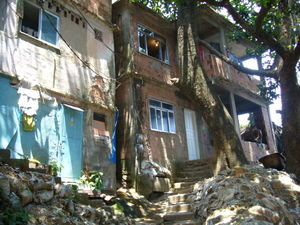Advertisement
Published: October 14th 2007

 Rocinha - Favella District
Rocinha - Favella District
Houses built on unsafe foundations and on top of one another, until they eventually collapse.Sat 13th Oct:
Went out last night to the Lapa area for the Samba scene and listened to the music for just over an hour - tired after long day so came back and went to bed. Hostel was full.
Booked a tour of the Rocinha district - the largest slum area in Rio (200,000 pop.) The buildings of the district are called Favellas. A guide drove myself and six others to the outskirts of the district and from there we travelled on the backs of motorcycles as it was the quickest means of transport up the winding roads to Rocinha. They weaved through the traffic and after about 15 minutes we were overlooking the valley showing the wide expanse of houses,literally built on top of each other. After a brief background talk from the guide we went right into the heart of the area. I felt very out-of-place in the middle of a different culture. The people of the Favellas live in a cycle of poverty which affects every aspect of their lives. The average family sixe is nine, with the girls having children from 13 onwards. Unemployment is very high and the average wage or those who work

 Rocinho - largest slum district of Rio
Rocinho - largest slum district of Rio
200,000 live in the favellas of this subculture in a cycle of poverty.is R$400 (less than £100) per month. They sell off their roof space so another house can be built on top; this continues until the whole structure collapses.The district is tightly controlled by drug barons who make their fortunes from using the people of the Favellas to traffic the drugs. Killings per week are high between rival gangs or individuals who don´t conform to their laws. Police have not control in the area. All problems are resolved within the community. It´s difficult to break the cycle. No photographs were allowed in certain parts of the area. Lots of walking to see the lifestle in the Favellas and the work of various projects to try and help the children and young families. I felt as though I was just getting a glimpse of their real world - ´would need to be in their community for at least a week to really know it.
Asked to get dropped off near the Nova Cathedral after the tour, so that I cóuld have a look at its intertior; extensive feeling of spaciousness inside as there were no supporting pillars in its structure; its four huge stained glass windows stretched 60 metres to the
ceiling. Walked back to the Hostel via the Lapa Steps - detailed artistically tiled steps; didn´t feel safe in the area, particularly having been warned by four different locals en route.... which made me feel how conspicuous I must be! So a hasty retreat to the Hostel. 'Had a fish meal locally and and an hour´s nap; ´will have an night in - tired.
Advertisement
Tot: 0.117s; Tpl: 0.011s; cc: 10; qc: 46; dbt: 0.0912s; 1; m:domysql w:travelblog (10.17.0.13); sld: 1;
; mem: 1.1mb

 Rocinha - Favella District
Rocinha - Favella District
 Rocinho - largest slum district of Rio
Rocinho - largest slum district of Rio






